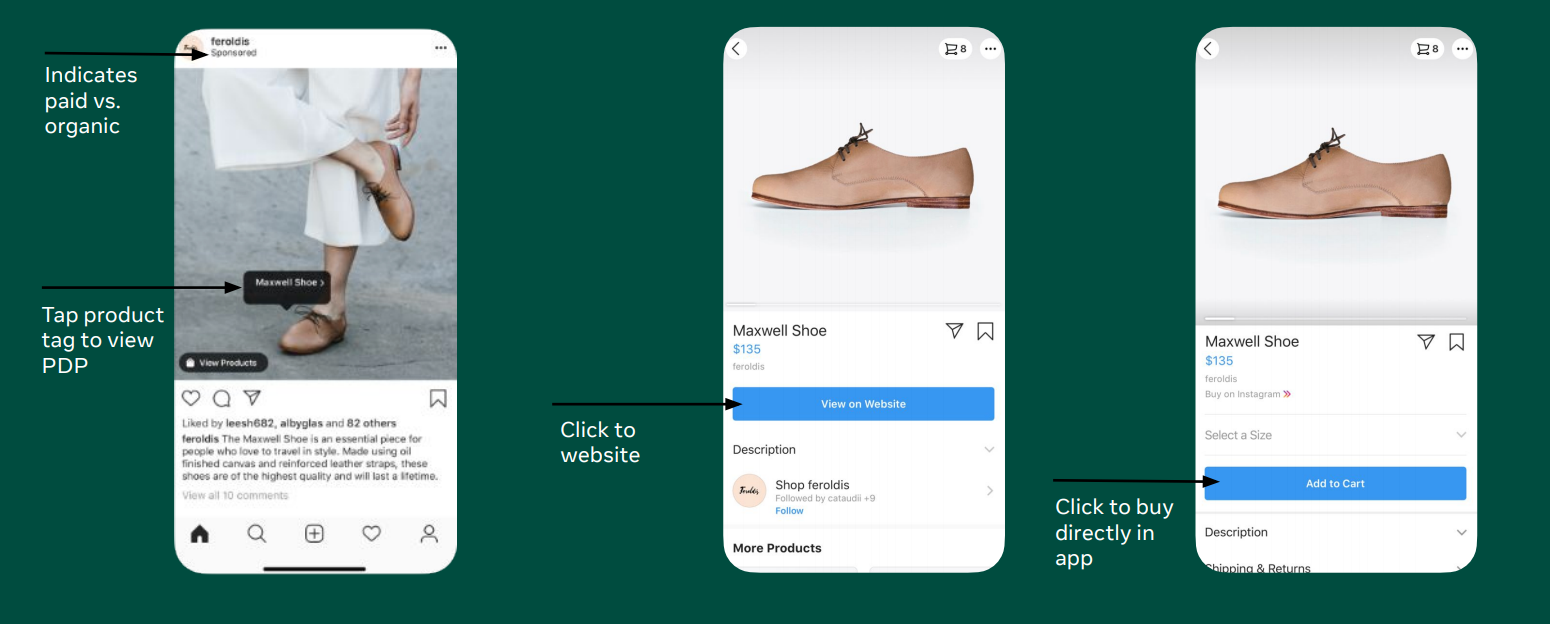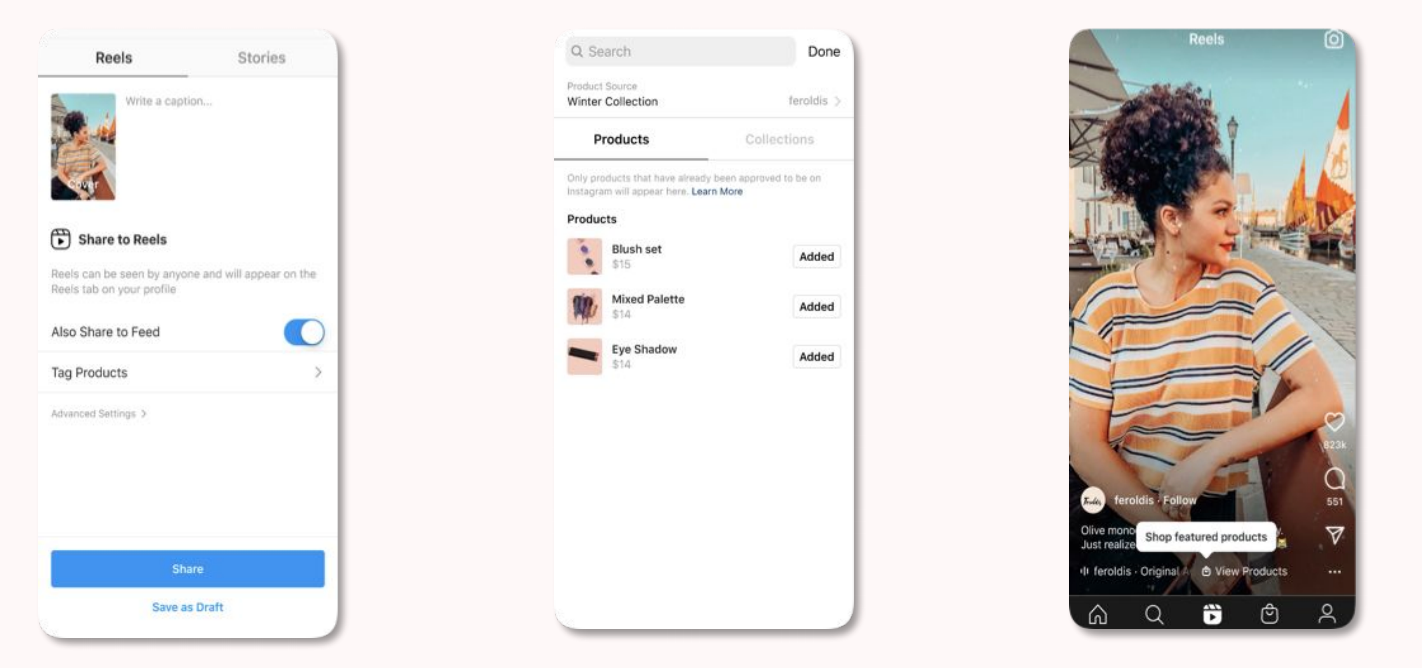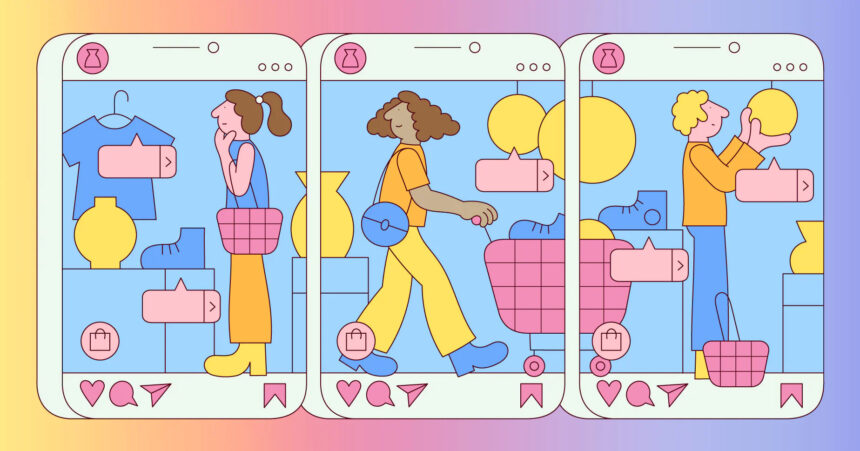Instagram attracts more than two billion active users who spend an average of 12 hours on the app each month. That’s a selling opportunity your brand can’t afford to ignore.
To sell on Instagram, businesses and creators use Instagram Shopping—the platform’s social selling solution. It turns your profile into a branded shopping experience, and gives approved accounts the ability to tag your products in posts, Reels, and Stories.
Learn how to sell on Instagram here. This post explains how to set up Instagram Shopping for your account, then gives you seven ways to help boost your IG sales.
What is Instagram Shopping?
Instagram Shopping is a set of features that allow people to buy your products on Instagram. With Instagram Shopping, you can create a store on your profile and tag your products in posts and videos.
Instagram Shopping features include:
- Shopping tags: Tag products in Reels, Stories, and posts to direct viewers to your online store.
- Storefront: Share your brand story and create product pages and collections on Instagram.
- Checkout: Allow shoppers to purchase in-app, instead of visiting your online store (US only).
How to set up Instagram Shopping for your brand
The easiest way to set up Instagram Shopping and start selling on the platform is to use Shopify. When you set up a Shopify store, you can integrate the Instagram sales channel to sync your product catalog with Instagram.
You can also sell on Instagram without Shopify. To do that, you’ll need to upload your product catalog to Meta Commerce Manager before your items can be tagged or bought on Instagram.
Either way, you’ll need an Instagram business profile to start. Here’s how to set up Instagram Shopping in three simple steps:
1. Create an Instagram business profile
First up, you’ll need an Instagram business profile. You can create a new profile and turn on business features, or convert your existing account. To start a business account on Instagram:
- Go to your profile and tap on the hamburger icon in the upper right corner.
- Tap “Settings and privacy,” then “Account type and tools.”
- Select “Switch to professional account.”
- Pick a category that best describes your business.
This is a good time to make sure your business and products comply with Instagram’s commerce policies.
💡 You’ll also need a Meta Business Manager account to upload and manage your products in Meta Commerce Manager in the next step. Once you’ve made an account, you can use Business Manager to sell on Facebook, too.
2. Add or sync your product catalog
Next, it’s time to add your products. You can do this manually, or by integrating your Shopify store.
Manually create your product catalog
To manually upload a product catalog, create a Commerce Manager account.
Meta Commerce Manager is where your product data will be stored. You’ll use Commerce Manager to upload a product catalog, customize your shop, and create product collections.
When you’ve made it into Commerce Manager, click “Add catalog.”

Then choose a catalog type to create. If you’re an online retailer, you’ll want to create an ecommerce catalog.

Upload your inventory. Select “Upload product info” and add the following information for each of your products:
Sync your Shopify product catalog
If you already have a catalog of products on a Shopify store, there’s no need to enter them again. Instead, install the Facebook and Instagram app and connect your accounts.
It takes up to 48 hours for Instagram to review your products. Then, you can use Shopify to customize your Shop, create Instagram ad campaigns, and track orders made by Instagram users.
3. Activate shopping on your Instagram account
Once you’ve created a business account and added products to your catalog, you’re ready to enable Instagram Shopping.
- Go to your Instagram profile settings.
- Tap Business, then tap Shopping.
- Connect to your product catalog.
When that’s done, you should be ready to promote your shop, tag products in posts, and create Instagram Shopping ads.
How to sell on Instagram: 7 effective tips
- Partner with influencers
- Run Instagram ads
- Use product tags
- Publish reels
- Curate user-generated content
- Use the right hashtags
- Use video to showcase your product
With your Instagram shop set up, harness these seven Instagram marketing tips to start bringing in sales.
1. Partner with influencers
In recent years, many businesses have turned to TikTok in search of personalities to promote their products. But Instagram is where the phenomenon of social media influencers took off, and influencer activity on the platform remains high.
Instagram influencers are part of a $21 billion market. They work as your brand ambassador, attaching their reach and reputation to your products, boosting your visibility among their target audience.

Influencers can impact buying habits because of their authority in a particular industry. In the example above, @lizarch, a yoga influencer with more than 53,000 followers, promotes a giveaway for essential oil company Savhera. The brand partnered with Liz because her audience trusts her wellness and lifestyle suggestions.
Don’t be fooled into thinking that every influencer charges Kim Kardashian money to promote products and brands. Accounts with smaller followings, who are nonetheless influential in a specific niche, often charge reasonable rates and may create content in exchange for free products.
In fact, these micro-influencers (defined as having fewer than 20,000 followers) can be the most impactful when it comes to promoting your goods.
According to Rhiannon Taylor, founder of gardening accessories store RT1home, which sells products on Instagram, “Nano-influencers and micro-influencers tend to get higher engagement rates. (The) best influencers have been people that are genuinely interested in the product and eager to share it with their followers.”
2. Run Instagram ads
Instagram is now a mainstream shopping destination. After posting and scrolling, browsing products is the third-most-popular reason people use the platform.
With mobile sales projected to reach $552.28 billion by the end of 2024 in the US, Instagram launched shoppable ads to capitalize on mobile commerce.

Shoppable Instagram ads are like your standard Instagram ad, but with product tags. When someone is interested in a promoted product, they can go directly to its product detail page or your website to learn more. If you’re a US business, you can also run ads with Instagram checkout, so people can purchase directly in-app.
Insta ads run in feeds or the Explore page using single image, carousel, or video formats from your product catalog. They work just like regular Instagram ads: you build them in Ads Manager and can show them to a custom audience or lookalike audience to find new potential customers.
3. Use product tags
The path from product discovery to purchase is not linear on Instagram. As your customers are scrolling, tags give them a chance to switch tasks and easily find out more about a product. They can visit your website at the moment of discovery, and even make a purchase from Instagram itself.

Tag products in your posts, Stories, and Reels so people can easily shop wherever they find joy in the app. If you’re a business with checkout-enabled shopping, you can also tag Live feeds.
If your goal is to get your product in front of more customers, it’s worth knowing that tagged products can also appear in users’ Explore feeds.
Users can also tag your products. When your product receives a tag, you’ll get a notification. You can view all tagged content on your profile and control tagging permissions in settings.

According to Instagram, 1.6 million people tag at least one product each week. Using product tags can help expand product awareness and drive potential customers to your products.
4. Publish Reels
Reels let your business create and publish videos up to 60 seconds long. It’s easy to get creative with text overlays, AR filters, and popular background music to tell your brand’s story. Reels can also appear on the Explore page, where anyone on Instagram can see them.
The coolest part? You can tag products in your Reels, so that when someone views your Reels they can easily access any products or collections mentioned.

5. Curate user-generated content
If people are buying and enjoying your product, chances are they’re posting about it on social media. User-generated content is a great way to fill your Instagram feed with quality content while still taking advantage of Instagram Shopping features.
For an example of a brand leveraging user-generated content, take a look at tattoo company Inkbox. They curate and repost mentions and recommendations to their 1.5 million Instagram followers.

Direct-to-consumer (DTC) brand Vuori also leverages a user-generated Instagram content strategy. Nikki Sakelliou, the company’s chief marketing officer, told Glossy Vuori initially was hesitant about tagging products and featuring user posts in its feed. But thanks to the success of the approach, about half of Vuori’s posts are now shoppable.
Many brands have come to see social media marketing as the gateway that lets them connect authentically with audience members one on one. With user-generated content, brands give users the opportunity to tell real and relatable stories—something that can be hard to achieve with traditional content.
6. Use the right hashtags
Instagram hashtags make your shoppable content discoverable on Instagram and help it reach more people. Hashtags also influence how the Instagram algorithm treats your content when deciding whether to serve your posts in user feeds or Explore.
When you add a hashtag to your post, the Instagram algorithm sees it as a hint about your post’s contents. It’s another way of telling Instagram, “My post is relevant to this topic.” If your hashtags are on point, Instagram will show your post to people who are interested in similar things.
If you already have a good idea of hashtags that work well for your brand, consider using them on your Shoppable posts. You can go broad with a hashtag like #style or #fashion, or something more specific like #earringsaddict. Either way, you’ll be helping Instagram match your posts with the right people.
7. Use video to showcase your product
Did you know that after watching a video, 78% of viewers are more likely to purchase a product online? Needless to say, video should be an integral part of your Instagram marketing strategy.
Letterfolk, for example, does a great job of using video in its Stories. From product demonstrations to live Q&A, the Letterfolk team knows exactly how to take advantage of this compelling format.

The best product videos tell stories that connect on a deep level with the viewer. The better you tell stories about your brand or product, the more likely your viewers are going to understand what your company is offering and what it can do for them. And, in turn, the more likely they’ll be to buy.
Don’t forget to add product stickers to your Stories to drive sales. Also consider pinning videos as highlights below your bio to surface them to new profile visitors.
Best practices for video content include:
- Short duration. If you’re creating a video ad, make it between six and 10 seconds.
- Design for Sound Off. Don’t assume viewers have their volume turned up.
- Frame your story. Use a vertical aspect ratio to fit phone screens.
How are you using Instagram to sell products?
Instagram Shopping is just the beginning for entrepreneurs looking to boost sales on Instagram. The content you create, your posting schedule, and the way to interact with followers all impact your sales figures. As more shoppers turn to social commerce, it’s up to your brand to join the conversion and make it simple for social media users to find your products.
Illustration by Martina Paukova.
Selling on Instagram FAQ
Yes. With Instagram Shopping, you can sell directly on Instagram by tagging products in posts, Reels, and Stories, as well as converting your profile to a Shop with product pages and collections. If you’re a US business or creator, your customers can also check out directly on Instagram.
How do beginners sell on Instagram?
The main ways for beginners to sell on Instagram include:
- Product tags
- Instagram ads
- Influencer partnerships
- Hashtags
Does it cost to sell things on Instagram?
There is no cost to tag products on Instagram and send users to your online store. However, Instagram charges a processing fee of 2.9% when users check out directly on Instagram. This fee does not apply to Shopify merchants using the Facebook and Instagram app, who are charged payment processing fees by Shopify directly.
How do I accept payment on Instagram?
You can accept payments on Instagram if you are a US-based business or creator with a US bank account and address. You can enable payment features through your Meta Commerce Manager or Business Manager accounts. Everyone else can use Instagram Shopping to direct customers to your online store.







